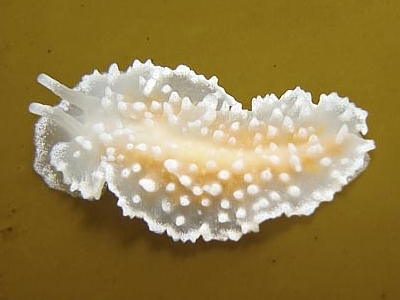
Charcotia granulosa
(Vayssiere, 1906)
Order: NUDIBRANCHIA
Suborder: ARMININA
Family: Charcotiidae
DISTRIBUTION
Known only from Antarctic Peninsula and nearby Wandel Is [= Booth Island]; and South Orkney Islands [Signy Ids.]
PHOTO
Locality: Cuverville Island, Antarctic Peninsula, Southern Ocean, 12 meters. Length 25 mm. 8 February 2007. Rock wall. Photos: David Cothran
Charcotia granulosa, was described from a single preserved specimen (Vayssiere, 1906). More recently a few living animals were found and described (Wagele et al, 1995) which look very similar to this photo. The shape is similar to an arminid, with a broad mantle skirt overlapping the body down each side but with a gap in the anterior midline. There is a broad oral veil and the genital openings and anal papillae are on the right side of the body. There are conical papillae scattered over the mantle along the mantle edge. The digestive gland forms a solid mass but there are a few branches running up to the the mantle edge but never into the oral veil or foot. The branches are often visible through the translucent body wall.
The rhinophores are describes as 'petal-like, laterally compressed; tips digitiform' [Wagele et al, 1995] but appear long smooth and cylindrical in this photo.
-
Vayssière, A. (1906) Diagnoses generiques de mollusques gasteropodes nouveaux rapportes par l'Expedition Antarctique de Dr. Charcot. Bulletin du Museum National d'Histoire Naturelle Paris 12: 147-149.
-
Vayssière, A. (1906) Mollusques Nudibranches et Marseniades. Expedition Antarctique Francaise (1903-1905). Commandee par le Dr. Jean Charcot. Mollusques. pp. 1-51. pls. 14.
-
Wägele, H. (1991) Studies on the morphology and anatomy of the Antarctic nudibranch genera Pseudotritonia Thiele, 1912 and Telarma Odhner, 1934 with a discussion of the family Charcotiidae Odhner, 1926 (Nudibranchia: Opisthobranchia). Zoological Journal of the Linnean Society 101: 359-389.
-
Wägele, H., Barnes, D. K. A., and Bullough, L. W. (1995) Redescription of Charcotia granulosa Vayssière, 1906 (Nudibranchia: Arminoidea: Charcotiidae) from Signy Island, Antarctica. Journal of Molluscan Studies 61: 197-207.
Rudman, W.B., 2007 (February 21) Charcotia granulosa (Vayssiere, 1906). [In] Sea Slug Forum. Australian Museum, Sydney. Available from http://www.seaslugforum.net/find/chargran
Related messages
Re: Charcotia granulosa from the Antarctic Peninsula
March 19, 2010
From: Kevin Lee

Concerning message #23342:
Thanks for the ID correction, Doc.
Responsive to your query, here are a few images of the C. granulosa crawling on the orange-red colored "whatever-it-is", perhaps algae, on which I found the slug. In the frigid water, I didn't linger long enough to find out if the slug was actually feeding on it.
Locality: Verdansky, 30 feet, Antarctic Peninsula, Southern Ocean, 14 March 2009, Rocky sloping reef. Length: 3/4 inch. Photographer: Kevin Lee.
Cheers,
Kevin
www.diverkevin.com
diverkevin@gmail.com
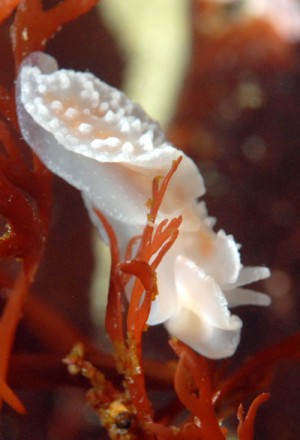

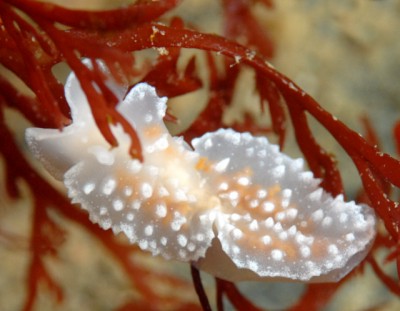
Dear Kevin,
Thanks for your quick response. I am definitely more comfortable lingering over your photos on a sunny Sydney day than you were taking them in Antarctic waters!
I agree the red-orange object is algal, which means there is something animal and orange, and probably cnidarian, nearby.
Best wishes,
Bill Rudman
Charcotia granulosa from the Antarctic Peninsula
March 18, 2010
From: Kevin Lee
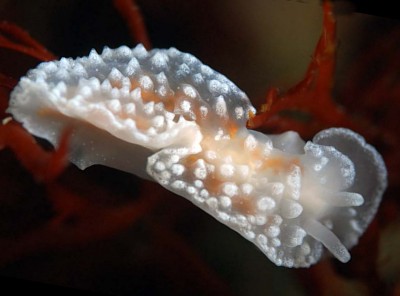
Here is Pseudotritonia antarctica another Antarctic sea slug for the forum.
Locality: Verdansky, 30 feet, Antarctic Peninsula, Southern Ocean, 14 March 2009, rocky slope. Length: 3/4 inch. Photographer: Kevin Lee.
Best wishes,
K:-)
diverkevin@gmail.com
Lee, K., 2010 (Mar 18) Charcotia granulosa from the Antarctic Peninsula. [Message in] Sea Slug Forum. Australian Museum, Sydney. Available from http://www.seaslugforum.net/find/23342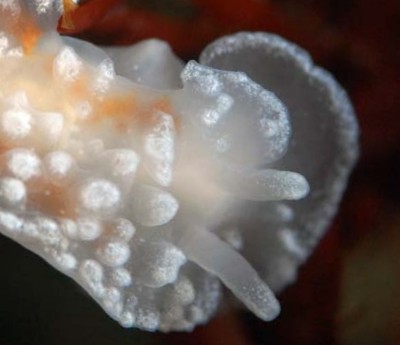
Dear Kevin,
This animal certainly has the digitiform rhinophores that Pseudotritonia antarctica is reported to have, but that species only has tubercles around the mantle edge. I am pretty sure your animal is the related Charcotia granulosa, which has tubercles scattered all over its back.
Have you any idea what the orange branching colony the animal is crawling on is? from the orange contents in the digestive gland it may well be the animal's food. If so it would be a useful addition to outkowledge of this antarctic species.
Best wishes,
Bill Rudman
Charcotia granulosa from Antarctica
January 27, 2010
From: Erling Svensen

Here is a photo of Charcotia granulosa from Antarctic peninsula last year.
Locality: Antarctic peninsula, 15 meter, Anarctica, March 2008. Length: 4 cm. Photographer: Erling Svensen.
Erling Svensen
erling@egersund.com
2010 (Jan 27) Charcotia granulosa from Antarctica. [Message in] Sea Slug Forum. Australian Museum, Sydney. Available from http://www.seaslugforum.net/find/23039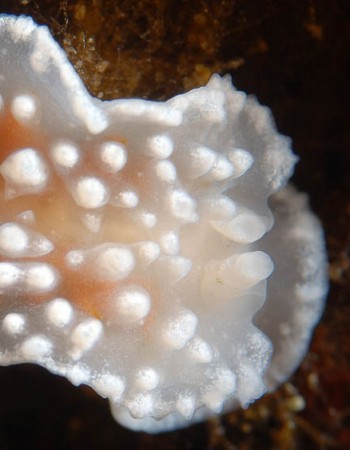
Dear Erling,
Thanks for this photo. There are very few photos of the living animal, so this is of great interest. In an earlier message on Charcotia granulosa [#19508] I discuss how the tentacular shape of the rhinophores [head tentacles] in the accompanying photo is rather different from Heike Wagele's description of 'flap-like' tentacles in her description of preserved animals. Your photo explains the difference as it shows a flap-like base and a short tentacles which I presume can greatly extend when the animal is not disturbed.
This is an interesting new bit of information
Best wishes,
Bill Rudman
Charcotia granulosa from Antarctica
February 22, 2007
From: David Cothran
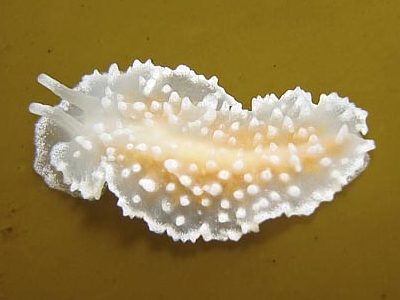
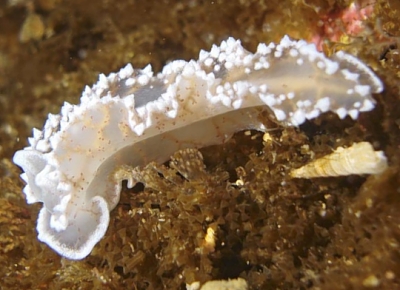
Hi Bill,
I am a long term admirer of the Sea Slug Forum - it has been a fantastically useful resource for my work a marine naturalist for Lindblad Expeditions.
I have been diving in the Antarctic for the past 6 Austral summers and thought you might enjoy seeing a couple of the nudibranchs I have photographed; one of them has been puzzling me.
Locality [for 1st image]: Cuverville Island, Antarctic Peninsula, Southern Ocean, 12 meters. Length: 25 mm. 8 February 2007. Rock wall. Photos: David Cothran
The first image is, I believe, Charcotia granulosa, a moderately common species around the Antarctic Peninsula, relatively small and inconspicuous except for its white color.
The second image is one I took at first to be another C. granulosa. On close examination though, I noticed a number of odd characteristics, including the form of the rhinophores, the web of orange veins and the reddish dots associated with them. I have photographed a number of C. granulosa specimens and never seen these characters before.
What do you think?
Best regards,
David Cothran
david@wandering-eye.com
Cothran, D., 2007 (Feb 22) Charcotia granulosa from Antarctica. [Message in] Sea Slug Forum. Australian Museum, Sydney. Available from http://www.seaslugforum.net/find/19508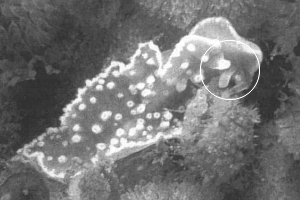
Dear David,
Thanks very much for these interesting additions to the Forum. I think it's worth mentioning at this stage that our knowledge of the Antarctic opisthobranchs is based on a little preserved material and a little more recently collected material, some of which includes information on the living animals. Our biggest problem then is matching the original material, which was usually described from preserved, often distorted material, and lacks information on the shape and colour of the live animals, with more recently collected material, or photos like yours.
Your upper animal is almost certainly Charcotia granulosa, which was described from a single preserved specimen (Vayssiere, 1906). More recently, a few living animals were found and described (Wagele et al, 1995) and they look very similar to your photo. However one major difference is that they describe the rhinophores as 'petal-like, laterally compressed; tips digitiform', which seems rather different from the long smooth cylindrical rhinophores in your photo. Looking at their photo [see black & white copy alongside] it seems that the laterally compressed basal part of the rhinophores in their specimen may represent a partially contracted state. This example certainly illustrates the fairly primitive state of our knowledge. Any photos and information you can send will be of great value.
I think I will deal with your second photo in a separate message [#19509]. Although it has similarities to Charcotia, in that genus there are a few branches of the digestive gland running up to the the mantle edge but never into the oral veil and foot. However you can see in your photo that the brown branches of the digestive gland extend into the oral veil and down along the edge of the foot. I suspect it is Pseudotritonia quadrangularis but I will discuss that separately
One thing it would be nice to get a photo of is the right side of the body of either, or both of these species. Species of this family have a glandular band running along the right side of the body from the genital openings back toward the tail. I have no idea what it looks like in the living animal but I suspect it will be an opaque white line.
Best wishes,
Bill Rudman
